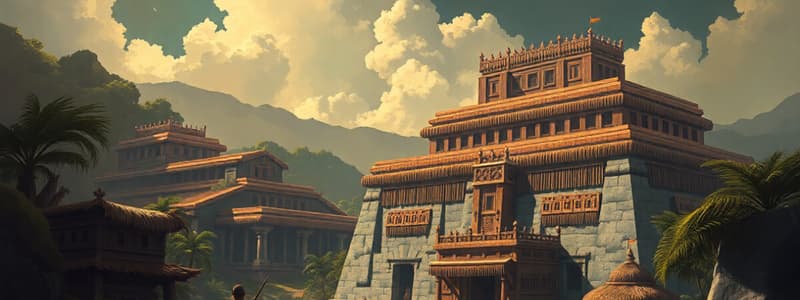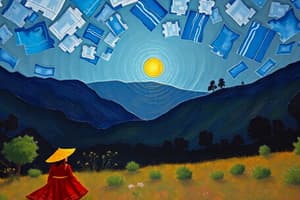Podcast
Questions and Answers
What was one of the primary social roles of material things and natural places in ancient Andean communities?
What was one of the primary social roles of material things and natural places in ancient Andean communities?
- To function as art objects for aesthetic appreciation
- To reflect the technological advancements of the time
- To create and maintain social relationships (correct)
- To serve as symbols of individual wealth and power
What was the essential point regarding ancient Andean objects as stated in the essay?
What was the essential point regarding ancient Andean objects as stated in the essay?
- They should be categorized solely as works of art
- They were primarily created for practical usage only
- They cannot be reduced to categories like 'wealth' and 'art' (correct)
- They are best understood through modern economic models
How did the Inka Empire influence the understanding of material culture in the Andes?
How did the Inka Empire influence the understanding of material culture in the Andes?
- By imposing its own vision of world order upon local practices (correct)
- By enforcing a unified religion that abolished local beliefs
- By promoting written records of indigenous perspectives
- By completely replacing indigenous social structures
What determined much of our knowledge regarding ancient Andean cultural perspectives?
What determined much of our knowledge regarding ancient Andean cultural perspectives?
What aspect of the Andean worldview remained intact despite the Spanish colonization?
What aspect of the Andean worldview remained intact despite the Spanish colonization?
What is the primary focus of anthropological studies regarding indigenous Andean people?
What is the primary focus of anthropological studies regarding indigenous Andean people?
Which language, besides Quechua, is identified as a major indigenous language of the Andes?
Which language, besides Quechua, is identified as a major indigenous language of the Andes?
How do modern anthropologists approach the study of Andean cultures?
How do modern anthropologists approach the study of Andean cultures?
What significant change occurred in the usage of the Quechua language after the Spanish invasion?
What significant change occurred in the usage of the Quechua language after the Spanish invasion?
What common theme is highlighted in the accounts of Spaniards and indigenous Andean people during the sixteenth and seventeenth centuries?
What common theme is highlighted in the accounts of Spaniards and indigenous Andean people during the sixteenth and seventeenth centuries?
Flashcards
Ancient Andean Material Culture
Ancient Andean Material Culture
Objects and natural places held significant social roles in ancient Andean communities, shaped by cultural perspectives, rather than modern categories like 'wealth' or 'art'.
Andean Cultural Perspectives
Andean Cultural Perspectives
Ancient Andean cultures viewed the world as interconnected, recognizing powerful forces (mountains, rivers, celestial beings, ancestors) as essential components of everyday life.
Inka Influence
Inka Influence
The Inka Empire's rule altered some objects' meanings, imposing its own vision of world order.
Ethnohistorical Research
Ethnohistorical Research
Signup and view all the flashcards
Andean Worldview
Andean Worldview
Signup and view all the flashcards
Andean Cultural Studies
Andean Cultural Studies
Signup and view all the flashcards
Quechua Language
Quechua Language
Signup and view all the flashcards
Colonial Texts
Colonial Texts
Signup and view all the flashcards
Indigenous Andean Concepts
Indigenous Andean Concepts
Signup and view all the flashcards
Anthropological Studies
Anthropological Studies
Signup and view all the flashcards
Study Notes
Indigenous Andean Cultural Perspectives on Material Objects and Natural Places
- Material objects and natural places held key social roles in ancient Andean communities
- Understanding their meaning and function requires examining cultural perspectives before and during the Inca Empire
- Andean objects cannot be simply categorized as "wealth" or "art"
- Objects were created for interacting with powerful forces (mountains, rivers, celestial beings, ancestors) and establishing social relationships
- Inca Empire's rise changed some meanings of objects and the importance of their vision of world order
- Despite Inca and Spanish conquest, Andean communities held onto their traditional views of the world
- The world is seen as a broader community of living beings, including non-humans
- Knowledge of these perspectives derived from modern ethnohistory and ethnography, not written records
Andean Cultural Perspectives and Concepts
- Understanding Andean material culture requires examining "animism"
- Objects viewed and treated as living entities (similar to nature and culture, humans, and non-humans)
- Natural places (water springs, peaks) have names and personalities and received offerings
- If offerings weren't made, water springs might dry up
- Peoples recognized animate qualities in material objects (buildings, pottery, tools)
Andean Cultural Perspectives and Concepts (Continued)
- Objects needed materials from their homelands to maintain their purpose and potency
- Peoples also used materials to mark social boundaries and differences between communities
- Objects and their use were used to communicate with non-human entities
- This is a form of governance and exploitation
- Andean people valued objects for their historical significance.
Summary
- Indigenous Andean concepts are vital to understanding their material culture
- Ancient objects and artifacts played essential roles in social life and community
- The objects were seen in terms of social function, religious symbolism, and beauty
- Inka objects tried to encapsulate other Andean peoples in their political empire
Studying That Suits You
Use AI to generate personalized quizzes and flashcards to suit your learning preferences.
Related Documents
Description
Explore the rich cultural significance of material objects and natural places in ancient Andean societies. This quiz delves into the social roles of these elements before and during the Inca Empire, highlighting how cultural perspectives shaped their meanings and functions. Discover how historical changes affected these views while traditional concepts persisted despite colonial influences.




